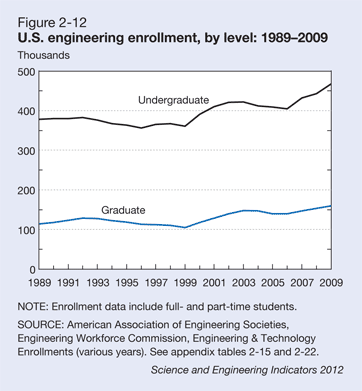Two of my children have the same high school math teacher that I had. At one parent night, he spoke about how students that successfully completed the math program at the school went on to top colleges, and into good careers like business and law. Noticing me, he took a bit of a departure from his standard monologue to lament that in my day, the students in the program would mostly go into engineering, science, and medicine. In fact, the top three students in my year became a doctor, mathematician, and mechanical engineer, respectively. My former teacher's lament is well-founded. Until recently, the number of students enrolled in science and engineering degrees had not kept pace with the increase in population, and of that enrollment, a larger percentage each year come from other countries. Additionally, the type of engineer matters, and we will soon reach a crisis that has no plan B.
In the US, we have 450,000 licensed professional engineers (about 0.1434% of population). These engineers hold the legal responsibility for the design and performance of buildings, infrastructure (pipelines, roads, water treatment, etc.), and technology (cars, computers, etc.). Every day, almost every activity we pursue involves the work of an engineer. Over the coming years, as our infrastructure continues to crumble and need repair, as we need to rehabilitate our buildings and build new ones for a population that will grow by thirty percent over the next thirty-five years, and as we need to solve the problems of climate change and resource distribution, we will need to add between 2,500 and 3,500 licensed engineers each year to keep pace with population growth and expanding needs. This need comes amidst three challenges: aging population of existing engineers, increased opportunity abroad for foreign-born engineers, and uneven distribution of engineers by discipline.
Assuming a population distribution similar to the population as a whole, over the next thirty-five years, an average of around 10,000 licensed engineers will retire each year. At the same time, each year we graduate between 70,000 and 90,000 engineers from the nation's universities. On the surface, this would suggest we have more than enough capacity. However, on average, only twenty percent of graduate engineers ever obtain their license, and therefore the legal authority to certify designs. Between the natural attrition to other professions, the difficulty in obtaining a license (which requires passing two exams and attaining four years experience in most states), and the declining pay relative to other professions, we produce between 14,000 and 18,000 licensed engineers each year. Additionally, until the last several years, that number had declines steadily since the early 1980s, and if we do not maintain, we will find ourselves scrambling to fill vacancies.
Even among these 14,000 to 18,000 licensed engineers we produce each year, the changing global landscape creates a pressure on the American marketplace. Thirty years ago, between three and five percent of graduates from engineering programs lived abroad, and many of them took jobs in the US after graduation. In 2008 through 2012, that number grew from sixteen percent to almost twenty-five percent. Add to this the opportunity to develop new cities in China, India, and the Middle East, and those foreign nationals who used to attend our top programs then stay now attend and go back to their country. If the trend continues, within a decade as many as one-third of the engineers graduating each year will come from abroad and return there. That reduces our numbers to between 9,500 and 12,000...not enough to keep up with the 13,000 we need at a minimum to keep pace.
Lastly, as with most needs in the labor market, specific skills matter. The growth in engineering over the last twenty years has come from biomedical engineering and computer engineering. Traditional engineering disciplines such as civil, mechanical, electrical (non-computer), and chemical have remained flat or slightly declined. This means that although in total number we may come close to replenishing our labor force, as those who design and maintain our roads, buildings, and infrastructure retire, we will have fewer ready to take their place. These foundations of our civil society get taken for granted, but when they start to fail, the cost to our economy and our security will be great.
In some ways, market forces can solve the problem, but we need even more than the hope of capitalism. As the number of engineers decline, and need remains, this should put an upward pressure on salaries and increase the desire of high school graduates to enter traditional engineering. We already see this in mining engineering which makes as much as twice other disciplines at entry level because the demand is high and supply small. We need to do more as a society, however. The risk of salaries not increasing enough, fast enough is too great. We need to encourage more young women and minorities to enter science and engineering to make up for declines among other demographics. We need to restore science and engineering's prominence, both financially and socially. We need to demand more technical knowledge across our economy. The great capitalists of the 19th century came from the technical class, not a class created in and of itself to manage. We see this resurgence in Silicon Valley, and we need to restore it to other sectors of our economy.
My children will not go into engineering, and neither will most of their classmates. If we do not do something as a society to change that, all the freedom and capital in the world will not prepare us for the consequences.

No comments:
Post a Comment